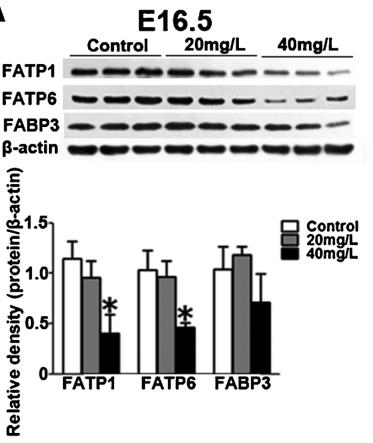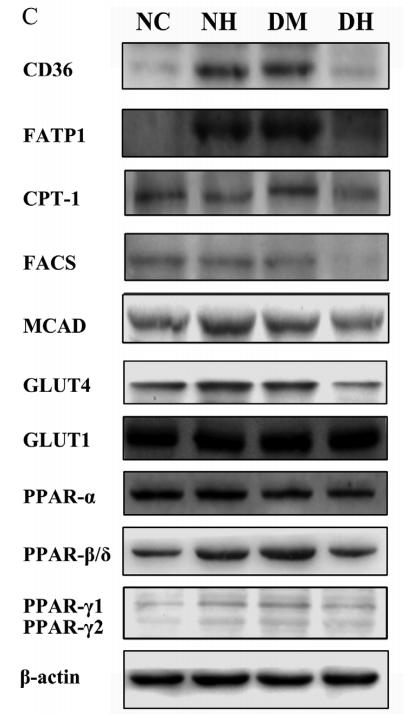FATP1 Antibody - #DF7716
| Product: | FATP1 Antibody |
| Catalog: | DF7716 |
| Description: | Rabbit polyclonal antibody to FATP1 |
| Application: | WB IF/ICC |
| Cited expt.: | WB |
| Reactivity: | Human, Mouse, Rat |
| Prediction: | Bovine, Horse, Sheep, Dog, Chicken |
| Mol.Wt.: | 65 kDa; 71kD(Calculated). |
| Uniprot: | Q6PCB7 |
| RRID: | AB_2841185 |
Related Downloads
Protocols
Product Info
*The optimal dilutions should be determined by the end user.
*Tips:
WB: For western blot detection of denatured protein samples. IHC: For immunohistochemical detection of paraffin sections (IHC-p) or frozen sections (IHC-f) of tissue samples. IF/ICC: For immunofluorescence detection of cell samples. ELISA(peptide): For ELISA detection of antigenic peptide.
Cite Format: Affinity Biosciences Cat# DF7716, RRID:AB_2841185.
Fold/Unfold
ACSVL5; FATP 1; FATP; FATP1; Fatty acid transport protein 1; FLJ00336; Long chain fatty acid transport protein 1; MGC71751; SLC27A1; Solute carrier family 27 (fatty acid transporter) member 1; Solute carrier family 27 member 1;
Immunogens
A synthesized peptide derived from human FATP1, corresponding to a region within the internal amino acids.
Highest levels of expression are detected in muscle and adipose tissue small, intermediate levels in small intestine, and barely detectable in liver.
- Q6PCB7 S27A1_HUMAN:
- Protein BLAST With
- NCBI/
- ExPASy/
- Uniprot
MRAPGAGAASVVSLALLWLLGLPWTWSAAAALGVYVGSGGWRFLRIVCKTARRDLFGLSVLIRVRLELRRHQRAGHTIPRIFQAVVQRQPERLALVDAGTGECWTFAQLDAYSNAVANLFRQLGFAPGDVVAIFLEGRPEFVGLWLGLAKAGMEAALLNVNLRREPLAFCLGTSGAKALIFGGEMVAAVAEVSGHLGKSLIKFCSGDLGPEGILPDTHLLDPLLKEASTAPLAQIPSKGMDDRLFYIYTSGTTGLPKAAIVVHSRYYRMAAFGHHAYRMQAADVLYDCLPLYHSAGNIIGVGQCLIYGLTVVLRKKFSASRFWDDCIKYNCTVVQYIGEICRYLLKQPVREAERRHRVRLAVGNGLRPAIWEEFTERFGVRQIGEFYGATECNCSIANMDGKVGSCGFNSRILPHVYPIRLVKVNEDTMELLRDAQGLCIPCQAGEPGLLVGQINQQDPLRRFDGYVSESATSKKIAHSVFSKGDSAYLSGDVLVMDELGYMYFRDRSGDTFRWRGENVSTTEVEGVLSRLLGQTDVAVYGVAVPGVEGKAGMAAVADPHSLLDPNAIYQELQKVLAPYARPIFLRLLPQVDTTGTFKIQKTRLQREGFDPRQTSDRLFFLDLKQGHYLPLNEAVYTRICSGAFAL
Predictions
Score>80(red) has high confidence and is suggested to be used for WB detection. *The prediction model is mainly based on the alignment of immunogen sequences, the results are for reference only, not as the basis of quality assurance.
High(score>80) Medium(80>score>50) Low(score<50) No confidence
Research Backgrounds
Mediates the ATP-dependent import of long-chain fatty acids (LCFA) into the cell by mediating their translocation at the plasma membrane. Has also an acyl-CoA ligase activity for long-chain and very-long-chain fatty acids. May act directly as a bona fide transporter, or alternatively, in a cytoplasmic or membrane-associated multimeric protein complex to trap and draw fatty acids towards accumulation. Plays a pivotal role in regulating available LCFA substrates from exogenous sources in tissues undergoing high levels of beta-oxidation or triglyceride synthesis. May be involved in regulation of cholesterol metabolism (By similarity).
Cell membrane>Single-pass membrane protein. Endomembrane system>Single-pass membrane protein. Cytoplasm.
Note: Plasma membrane and intracellular membranes, at least in adipocytes. In adipocytes, but not myocytes, insulin via the mTORC1 signaling pathway induces a rapid translocation of SLC27A1 from intracellular compartments to the plasma membrane, paralleled by increased LCFA uptake. Insulin-dependent translocation from the cytoplasm to the cell membrane is regulated by EPRS1. Predominantly cytoplasmic in myocytes.
Highest levels of expression are detected in muscle and adipose tissue small, intermediate levels in small intestine, and barely detectable in liver.
Belongs to the ATP-dependent AMP-binding enzyme family.
Research Fields
· Human Diseases > Endocrine and metabolic diseases > Insulin resistance.
· Organismal Systems > Endocrine system > PPAR signaling pathway.
References
Application: WB Species: mouse Sample: placenta
Application: WB Species: mouse Sample: myocardial
Restrictive clause
Affinity Biosciences tests all products strictly. Citations are provided as a resource for additional applications that have not been validated by Affinity Biosciences. Please choose the appropriate format for each application and consult Materials and Methods sections for additional details about the use of any product in these publications.
For Research Use Only.
Not for use in diagnostic or therapeutic procedures. Not for resale. Not for distribution without written consent. Affinity Biosciences will not be held responsible for patent infringement or other violations that may occur with the use of our products. Affinity Biosciences, Affinity Biosciences Logo and all other trademarks are the property of Affinity Biosciences LTD.



